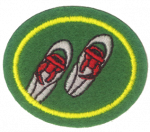AY Honors/Snowshoeing/Answer Key/es
| Senderismo con raquetas de nieve | ||
|---|---|---|
| Asociación General
|
Destreza: 1 Año de introducción: 2010 |
|
Requisitos
|
La especialidad de Senderismo con raquetas de nieve es un componente de la Maestría Recreación. |
1
2
2a
2b
2c
3
3a
3b
3c
3d
4
Mantener el calor
Adventist Youth Honors Answer Book/Maintaining body warmth/es
La hipotermia
Adventist Youth Honors Answer Book/First aid/Hypothermia/es
5
5a
5b
5c
5d
5e
6
The first thing to do when you fall is to check that you are not injured. Then roll onto your stomach, raise yourself up on all fours, pushing with your forearm until you can shift your weight to your knees. Assume a kneeling position. Then while steadying yourself with trekking poles (if you are using them), raise one knee and get the snowshoe beneath yourself. Then as you stand on that leg, get the other shoe into its proper position.
7
When traditional wooden shoes were still popular, it was common to buy the bindings separately (much like downhill skis), and many wooden shoes are still sold this way). They were commonly called "H" bindings, since they consisted of a strap around the heel crossing a strap around the toe and one at the instep, forming a rough version of that letter.
8
An excellent place to begin snowshoeing is on a golf course. The course will obviously not be used by golfers when it is covered with snow. Golf courses provide open spaces and gentle slopes. Other options are parks, hiking trails, and cross-country skiing trails.
9
Cleanse me with hyssop, and I will be clean;
wash me, and I will be whiter than snow.
The color white represents purity. In this verse, the psalmist compares sinlessness with the whiteness of snow. It is easy to see flecks of dirt in snow, and it is likewise easy to tell that snow is clean and pure. When we are cleansed of sin by Jesus, we are completely purified.
Referencias
- Categoría: Tiene imagen de insignia
- Adventist Youth Honors Answer Book/Honors/es
- Adventist Youth Honors Answer Book/es
- Adventist Youth Honors Answer Book/Skill Level 1/es
- Categoría: Libro de respuestas de especialidades JA/Especialidades introducidas en 2010
- Adventist Youth Honors Answer Book/General Conference/es
- Adventist Youth Honors Answer Book/Recreation/es
- Adventist Youth Honors Answer Book/Recreation/Primary/es
- Adventist Youth Honors Answer Book/Stage 0/es
- Adventist Youth Honors Answer Book/Recreation Master Award/es

